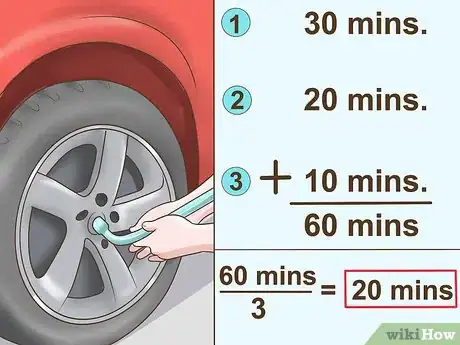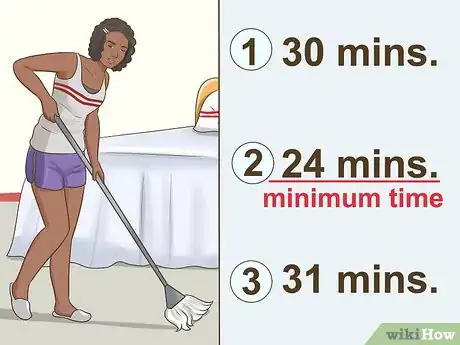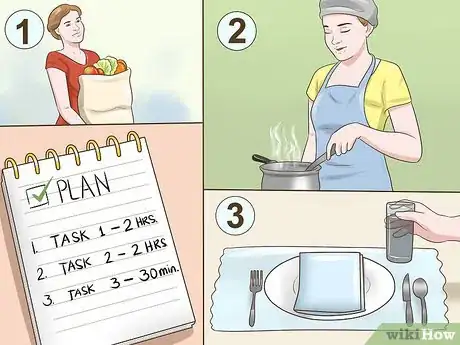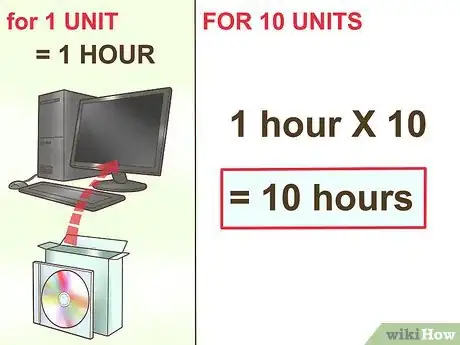This article was co-authored by wikiHow Staff. Our trained team of editors and researchers validate articles for accuracy and comprehensiveness. wikiHow's Content Management Team carefully monitors the work from our editorial staff to ensure that each article is backed by trusted research and meets our high quality standards.
There are 12 references cited in this article, which can be found at the bottom of the page.
This article has been viewed 21,911 times.
Learn more...
To more accurately estimate the time needed for tasks, you’ll need to clearly identify each part of the task. Get more granular and identify the substeps of each part. Track the time necessary for each aspect of the task and record the data. Use the data to develop an estimate. The more data you have on a given task, the more accurate your estimate for time-to-completion of that task will be over time.
Steps
Formulating Strong Estimates
-
1Use consistent past times to develop an estimate. If you’re completing a task that you’ve done before, you can draw on your own experience to develop a ballpark estimate of the time needed. If the task takes the same amount of time for each attempt, you will probably be able to accomplish the task in the same amount of time you did every previous time.[1]
- For instance, if you make sandwiches for lunch and it always takes eight minutes, you can estimate with a high degree of accuracy that your current sandwich will also take eight minutes to make.
-
2Use varying past times to develop an estimate. If the task you’re interested in developing an estimate for took a slightly different amount of time every time you did it, you can average the previous times it took you to complete the task in order to arrive at an estimate. Perhaps the tools you had on hand were different each time, or perhaps the first time you did the task, you didn’t know quite what you were doing. Whatever the cause, you can total the time spent on the task and divide by the number of instances to achieve an estimate.[2]
- For instance, if you’re changing tires and have changed your tires three times before with completion times of 30 minutes, 20 minutes, and 10 minutes, your total time is 60 minutes. Divided by three instances, you end up with an estimated time of 20 minutes to change your tires.
Advertisement -
3Use the experiences of others to estimate the time needed. In addition to drawing on your own experience to estimate how long it will take to complete a task, you can use the experience of others to arrive at a reasonable estimate. For instance, if you plan on swapping out your phone’s battery for a new one, you could ask friends who have the same phone how long it took them. You can average these time estimates or identify the median time to arrive at a reasonable estimate.[3]
- After identifying the task you wish to acquire an estimated time to completion for, ask a knowledgeable person how long they believe it will take to complete.
- If you do not know someone capable of providing such an estimate, consult web-based sources for an idea of how long it might take. Depending on the task you’re interested in completing, you might be able to find a reasonable estimate in books at your local library. Home repair tasks, arts and crafts projects, and recipes, for instance often list estimated times to completion based on the experience of the individual who authored the task directions.
-
4Draw on both types of estimations. If possible, use both your own past experiences and the experiences of others to arrive at the most accurate estimate of time needed for tasks. This will allow you to draw on the largest possible set of background data and thus estimate most accurately the time necessary for a given task.[4]
- Weighing both secondhand and personal experiences will allow you to avoid (or, at least, minimize the odds of) overestimating your own ability to accomplish a task quickly or within a given amount of time.
-
5Offer an optimistic estimate. An optimistic estimate is the minimum amount of time you expect a task will take. It’s based on the shortest time you previously accomplished a given task in. For instance, if you are trying to develop an estimate for the time you’ll need to clean your living room and the previous times required to clean your living room were 30 minutes, 24 minutes, and 31 minutes, your optimistic minimum estimate would be about 24 minutes, since it is the lowest number in the data set.[5]
- Avoid citing the minimum as an estimate, since it is based on only a single data point and will not be very accurate.
-
6Offer a pessimistic estimate. The most pessimistic estimate is based on the maximum amount of time you’ve ever spent on a single instance of a task. For instance, if you’ve cooked pancakes in 10 minutes, 20 minutes, and 15 minutes, you would choose 20 minutes as your pessimistic estimate, since it’s the longest time you’ve ever spent cooking pancakes. Like the minimum, it’s based on a single data point and therefore not very reliable.[6]
- Citing the maximum as your estimate will give a very conservative estimate.
-
7Offer the median as your estimate. The median is the middle number in a data set. For instance, if baking a cake takes 20 minutes one time, 22 minutes another time, and 23 minutes another time, the number in the set that is in the middle of the other numbers in the data set (22, in this case) is the median.[7]
Defining Larger Tasks
-
1Identify the steps needed to complete the task. Most tasks have several parts to them. Before you can accurately estimate the time needed for tasks, you must identify each component or step of the task, then calculate how long it will take to accomplish it.[8]
- For instance, in a business setting, you’ll need to agree on what the deliverables will be. You’ll then need to know long it will take to complete each step on the way to finalizing each deliverable. For instance, if you know you need to create a presentation, a report, and a prototype product, you can draw up three independent estimates then add them to arrive at your most accurate estimate.
-
2Ask for help when defining steps needed to complete the task. In business or other organizational settings, you often have tasks and substeps assigned by superiors. In these cases, you should already have a clear sense of what you need to accomplish, and consult your client or superior for more information regarding what each step requires.[9]
-
3Order your activities. On large projects, you often have many steps. You might be able to complete these steps in any order, or you might need to order your activities in a logical way. For instance, if you’re building a house, you’ll need to order your activities based on the order in which they are possible. You will have to add the time it takes to lay the foundation, the time it takes to assemble the frame, and so on.[10]
- In other cases – for instance, developing a new product – you and/or your team can work on multiple aspects of the product concurrently. For example, you might be able to develop ads and marketing for the product while another team develops a plan to showcase the product at relevant industry events. The estimated time to completion in this case is simply the longer of the two time estimates.
-
4Consult with your team. Some tasks require the input and assistance of others for completion. For instance, when writing a comic book, someone needs to write the script, then someone needs to draw the book, and someone else needs to ink the book. In these cases, get input from the other individuals involved in order to get the most accurate estimate needed to complete the task. Otherwise, you might end up estimating how long each step of the process will take with a low degree of accuracy.[11]
- Remember, if some people are working part-time on the task, they might not provide an accurate estimate if they switch roles.
- When you draft final time estimates, ask others on your team for input about whether or not the timeline in which you will complete the task seems valid.
- Assume that your team will only be productive 80% of the time. Be sure to factor in time for sick days, accidents, meetings, and other unforeseen problems.
-
5Stick to your plan. Assuming the task you’re trying to develop a more accurate estimate for began with a plan, follow the plan step-by-step until completion. Deviating from your plan will cause your estimate to become less accurate.[12]
- Sometimes it becomes inevitable that you have to abandon the initial plan in favor of a new one. If this occurs, revisit your initial estimate to determine how to compensate for the newly-revised plan.
-
6Use phased implementation. Phased implementation involves completing a task over a long period of time in which the discrete substeps or different parts of a task are completed in a linear way. Each stage of the task, once completed, enables forward motion toward the next stage of the task. This is especially useful in situations in which you’ll be producing or installing an identical system or product over and over again.[13]
- For instance, suppose your task is to install a new operating system on all ten computers in your office. After each installation, you’ll have another data point you can use to develop a more accurate estimate of how long it will take until the entire office has the new operating system.
-
7Track how much time you’re spending on a given task. To more accurately estimate the time needed for a given task, you must practice it repeatedly and track exactly how much time you’re actually doing it. The best way to track the time needed for tasks is to split them up into substeps, then accurately track each substep. With an ongoing data collection system, you’ll be able to develop ever-more accurate estimates for time needed to complete tasks.[14]
- Keep the data for tasks you expect to need an accurate estimate for again in the future.[15]
-
8Find ways to streamline your time-tracking. Depending on the task you’re trying to develop a time estimate for, you could use apps to track the time needed to complete it. There are apps available to track time, though you might be content to simply use a spreadsheet or pen and paper to track your time on a given task.[16]
- For instance, if you’re trying to track how long it takes you to run two miles and bike two miles, you could use a FitBit or similar fitness tracker, or an app like MobileTrack. Work-related time-tracking apps include Eon, Slips, Clockwork, and Punch.
- If you’re doing a more manual task, you could bust out a pen and pad of paper. Write each task you’re trying to get a more accurate estimate for in one column and the time it took to complete the task next to it.
- For instance, if you’re trying to get a more accurate estimate for how long it takes you to get out of the house each day, you might write a list that reads, “Get dressed – 4 minutes; Brush teeth – 3 minutes; Eat breakfast – 10 minutes,” and so on. Repeat daily, and average the task totals at the end of each day.
Including the Right Data
-
1Acknowledge negative outcomes. When drawing on your own experience (or even that of others), it is important not to exclude occasions when a particular task took an excessive or embarrassing length of time. If you had several negative outcomes (for instance, you previously accomplished a similar or identical task over a period greater than that which you wish to accomplish your present task), factor it into your estimation process. Never discount prior results simply because you are dissatisfied with them. This could cause you to underestimate or overestimate the time needed for tasks.[17]
-
2Attend to special conditions. If there are mitigating factors that could impinge on your ability to estimate the time needed for tasks, include them in your estimation process. For instance, if you know that you are a procrastinator, or if you have multiple tasks ahead of the new task you’re developing an estimate for, include those factors in your estimation process. Doing so will help you yield a more accurate final estimate for a given task.[18]
-
3Assign an accuracy rating to your estimate. Developing a more accurate estimate of the time needed for a given task does not require that your estimate be completely accurate. Use your familiarity with the task at hand as well as all relevant mitigating factors to assign the estimate an accuracy rating.[19] For instance, you might say, “I am 75% certain I can complete this in a week.”[20]
- If you wish, you could follow up with a more pessimistic estimate by saying something like “I am 100% certain I could finish this in two weeks.”
- Communicating your level of confidence in your estimate is especially important if you are developing a task completion estimate for someone else.
References
- ↑ http://web.mit.edu/curhan/www/docs/Articles/biases/67_J_Personality_and_Social_Psychology_366,_1994.pdf
- ↑ http://web.mit.edu/curhan/www/docs/Articles/biases/67_J_Personality_and_Social_Psychology_366,_1994.pdf
- ↑ http://web.mit.edu/curhan/www/docs/Articles/biases/67_J_Personality_and_Social_Psychology_366,_1994.pdf
- ↑ http://web.mit.edu/curhan/www/docs/Articles/biases/67_J_Personality_and_Social_Psychology_366,_1994.pdf
- ↑ www.projectsmart.co.uk/12-tips-for-accurate-project-estimating.php
- ↑ www.projectsmart.co.uk/12-tips-for-accurate-project-estimating.php
- ↑ www.projectsmart.co.uk/12-tips-for-accurate-project-estimating.php
- ↑ https://www.mindtools.com/pages/article/newPPM_01.htm
- ↑ https://www.mindtools.com/pages/article/newPPM_77.htm
- ↑ https://www.mindtools.com/pages/article/newPPM_01.htm
- ↑ https://www.mindtools.com/pages/article/newPPM_01.htm
- ↑ https://www.projectsmart.co.uk/12-tips-for-accurate-project-estimating.php
- ↑ https://www.projectsmart.co.uk/12-tips-for-accurate-project-estimating.php
- ↑ http://www.fngtps.com/2013/learning-to-estimate-development-time-accurately/
- ↑ https://www.projectsmart.co.uk/12-tips-for-accurate-project-estimating.php
- ↑ http://www.creativebloq.com/netmag/how-create-accurate-estimate-your-projects-41411340
- ↑ http://web.mit.edu/curhan/www/docs/Articles/biases/67_J_Personality_and_Social_Psychology_366,_1994.pdf
- ↑ http://web.mit.edu/curhan/www/docs/Articles/biases/67_J_Personality_and_Social_Psychology_366,_1994.pdf
- ↑ https://www.projectsmart.co.uk/12-tips-for-accurate-project-estimating.php
- ↑ http://www.fngtps.com/2013/learning-to-estimate-development-time-accurately/













































































